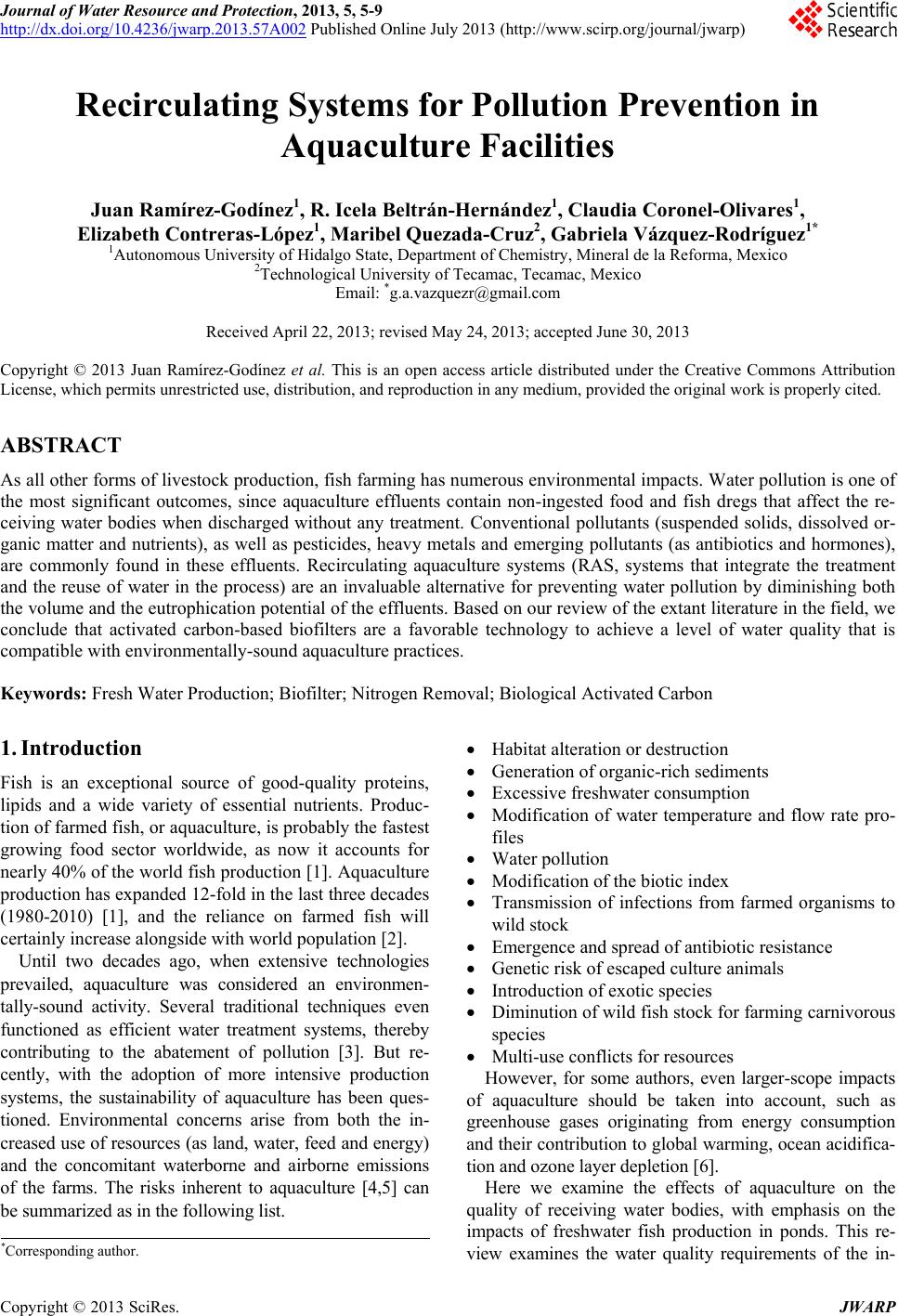 Journal of Water Resource and Protection, 2013, 5, 5-9 http://dx.doi.org/10.4236/jwarp.2013.57A002 Published Online July 2013 (http://www.scirp.org/journal/jwarp) Recirculating Systems for Pollution Prevention in Aquaculture Facilities Juan Ramírez-Godínez1, R. Icela Beltrán-Hernández1, Claudia Coronel-Olivares1, Elizabeth Contreras-López1, Maribel Quezada-Cruz2, Gabriela Vázquez-Rodríguez1* 1Autonomous University of Hidalgo State, Department of Chemistry, Mineral de la Reforma, Mexico 2Technological University of Tecamac, Tecamac, Mexico Email: *g.a.vazquezr@gmail.com Received April 22, 2013; revised May 24, 2013; accepted June 30, 2013 Copyright © 2013 Juan Ramírez-Godínez et al. This is an open access article distributed under the Creative Commons Attribution License, which permits unrestricted use, distribution, and reproduction in any medium, provided the original work is properly cited. ABSTRACT As all other forms of livestock production, fish farming has numerous environmental impacts. Water pollution is one of the most significant outcomes, since aquaculture effluents contain non-ingested food and fish dregs that affect the re- ceiving water bodies when discharged without any treatment. Conventional pollutants (suspended solids, dissolved or- ganic matter and nutrients), as well as pesticides, heavy metals and emerging pollutants (as antibiotics and hormones), are commonly found in these effluents. Recirculating aquaculture systems (RAS, systems that integrate the treatment and the reuse of water in the process) are an invaluable alternative for preventing water pollution by diminishing both the volume and the eutrophication potential of the effluents. Based on our review of the extant literature in the field, we conclude that activated carbon-based biofilters are a favorable technology to achieve a level of water quality that is compatible with environmentally-sound aquaculture practices. Keywords: Fresh Water Production; Biofilter; Nitrogen Removal; Biological Activated Carbon 1. Introduction Fish is an exceptional source of good-quality proteins, lipids and a wide variety of essential nutrients. Produc- tion of farmed fish, or aquaculture, is probably the fastest growing food sector worldwide, as now it accounts for nearly 40% of the world fish production [1]. Aquaculture production has expanded 12-fold in the last three decades (1980-2010) [1], and the reliance on farmed fish will certainly increase alongside with world population [2]. Until two decades ago, when extensive technologies prevailed, aquaculture was considered an environmen- tally-sound activity. Several traditional techniques even functioned as efficient water treatment systems, thereby contributing to the abatement of pollution [3]. But re- cently, with the adoption of more intensive production systems, the sustainability of aquaculture has been ques- tioned. Environmental concerns arise from both the in- creased use of resources (as land, water, feed and energy) and the concomitant waterborne and airborne emissions of the farms. The risks inherent to aquaculture [4,5] can be summarized as in the following list. Habitat alteration or destruction Generation of organic-rich sediments Excessive freshwater consumption Modification of water temperature and flow rate pro- files Water pollution Modification of the biotic index Transmission of infections from farmed organisms to wild stock Emergence and spread of antibiotic resistance Genetic risk of escaped culture animals Introduction of exotic species Diminution of wild fish stock for farming carnivorous species Multi-use conflicts for resources However, for some authors, even larger-scope impacts of aquaculture should be taken into account, such as greenhouse gases originating from energy consumption and their contribution to global warming, ocean acidifica- tion and ozone layer depletion [6]. Here we examine the effects of aquaculture on the quality of receiving water bodies, with emphasis on the impacts of freshwater fish production in ponds. This re- view examines the water quality requirements of the in- *Corresponding author. C opyright © 2013 SciRes. JWARP 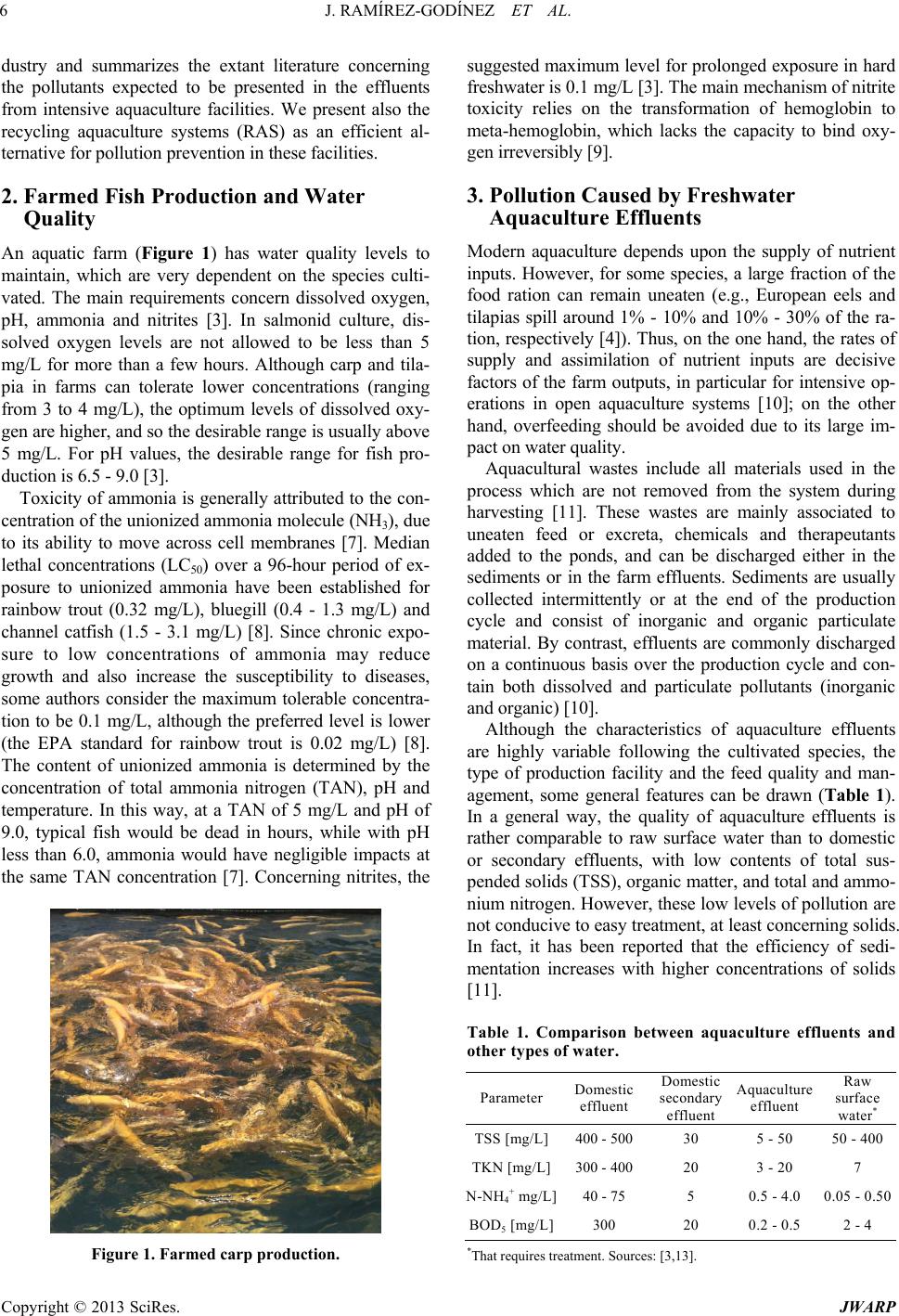 J. RAMÍREZ-GODÍNEZ ET AL. 6 dustry and summarizes the extant literature concerning the pollutants expected to be presented in the effluents from intensive aquaculture facilities. We present also the recycling aquaculture systems (RAS) as an efficient al- ternative for pollution prevention in these facilities. 2. Farmed Fish Production and Water Quality An aquatic farm (Figure 1) has water quality levels to maintain, which are very dependent on the species culti- vated. The main requirements concern dissolved oxygen, pH, ammonia and nitrites [3]. In salmonid culture, dis- solved oxygen levels are not allowed to be less than 5 mg/L for more than a few hours. Although carp and tila- pia in farms can tolerate lower concentrations (ranging from 3 to 4 mg/L), the optimum levels of dissolved oxy- gen are higher, and so the desirable range is usually above 5 mg/L. For pH values, the desirable range for fish pro- duction is 6.5 - 9.0 [3]. Toxicity of ammonia is generally attributed to the con- centration of the unionized ammonia molecule (NH3), due to its ability to move across cell membranes [7]. Median lethal concentrations (LC50) over a 96-hour period of ex- posure to unionized ammonia have been established for rainbow trout (0.32 mg/L), bluegill (0.4 - 1.3 mg/L) and channel catfish (1.5 - 3.1 mg/L) [8]. Since chronic expo- sure to low concentrations of ammonia may reduce growth and also increase the susceptibility to diseases, some authors consider the maximum tolerable concentra- tion to be 0.1 mg/L, although the preferred level is lower (the EPA standard for rainbow trout is 0.02 mg/L) [8]. The content of unionized ammonia is determined by the concentration of total ammonia nitrogen (TAN), pH and temperature. In this way, at a TAN of 5 mg/L and pH of 9.0, typical fish would be dead in hours, while with pH less than 6.0, ammonia would have negligible impacts at the same TAN concentration [7]. Concerning nitrites, the Figure 1. Farmed carp production. suggested maximum level for prolonged exposure in hard freshwater is 0.1 mg/L [3]. The main mechanism of nitrite toxicity relies on the transformation of hemoglobin to meta-hemoglobin, which lacks the capacity to bind oxy- gen irreversibly [9]. 3. Pollution Caused by Freshwater Aquaculture Effluents Modern aquaculture depends upon the supply of nutrient inputs. However, for some species, a large fraction of the food ration can remain uneaten (e.g., European eels and tilapias spill around 1% - 10% and 10% - 30% of the ra- tion, respectively [4]). Thus, on the one hand, the rates of supply and assimilation of nutrient inputs are decisive factors of the farm outputs, in particular for intensive op- erations in open aquaculture systems [10]; on the other hand, overfeeding should be avoided due to its large im- pact on water quality. Aquacultural wastes include all materials used in the process which are not removed from the system during harvesting [11]. These wastes are mainly associated to uneaten feed or excreta, chemicals and therapeutants added to the ponds, and can be discharged either in the sediments or in the farm effluents. Sediments are usually collected intermittently or at the end of the production cycle and consist of inorganic and organic particulate material. By contrast, effluents are commonly discharged on a continuous basis over the production cycle and con- tain both dissolved and particulate pollutants (inorganic and organic) [10]. Although the characteristics of aquaculture effluents are highly variable following the cultivated species, the type of production facility and the feed quality and man- agement, some general features can be drawn (Table 1). In a general way, the quality of aquaculture effluents is rather comparable to raw surface water than to domestic or secondary effluents, with low contents of total sus- pended solids (TSS), organic matter, and total and ammo- nium nitrogen. However, these low levels of pollution are not conducive to easy treatment, at least concerning solids. In fact, it has been reported that the efficiency of sedi- mentation increases with higher concentrations of solids [11]. Table 1. Comparison between aquaculture effluents and other types of water. Parameter Domestic effluent Domestic secondary effluent Aquaculture effluent Raw surface water* TSS [mg/L]400 - 500 30 5 - 50 50 - 400 TKN [mg/L]300 - 400 20 3 - 20 7 N-NH4+ mg/L]40 - 75 5 0.5 - 4.0 0.05 - 0.50 BOD5 [mg/L]300 20 0.2 - 0.5 2 - 4 *That requires treatment. Sources: [3,13]. Copyright © 2013 SciRes. JWARP 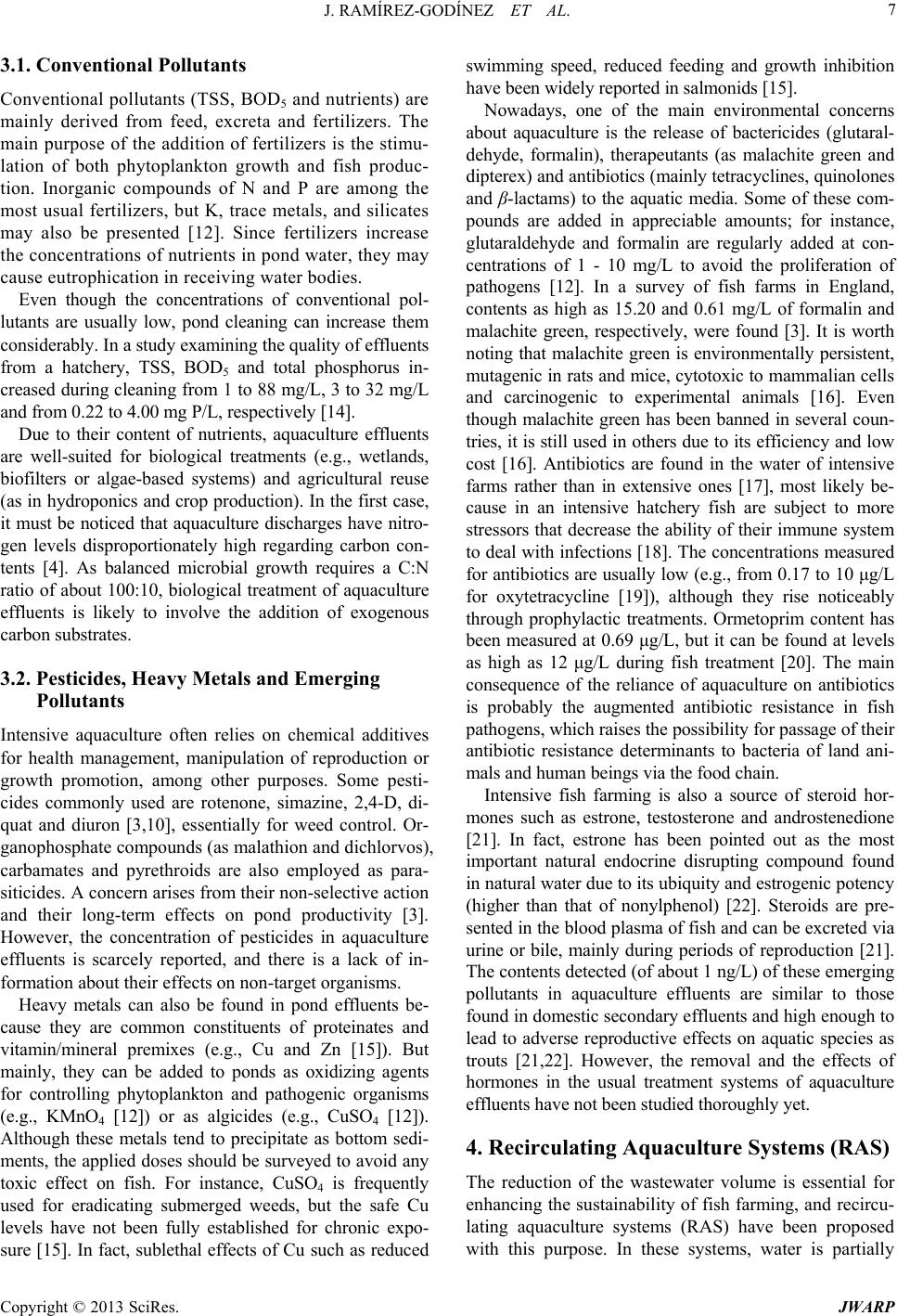 J. RAMÍREZ-GODÍNEZ ET AL. 7 3.1. Conventional Pollutants Conventional pollutants (TSS, BOD5 and nutrients) are mainly derived from feed, excreta and fertilizers. The main purpose of the addition of fertilizers is the stimu- lation of both phytoplankton growth and fish produc- tion. Inorganic compounds of N and P are among the most usual fertilizers, but K, trace metals, and silicates may also be presented [12]. Since fertilizers increase the concentrations of nutrients in pond water, they may cause eutrophication in receiving water bodies. Even though the concentrations of conventional pol- lutants are usually low, pond cleaning can increase them considerably. In a study examining the quality of effluents from a hatchery, TSS, BOD5 and total phosphorus in- creased during cleaning from 1 to 88 mg/L, 3 to 32 mg/L and from 0.22 to 4.00 mg P/L, respectively [14]. Due to their content of nutrients, aquaculture effluents are well-suited for biological treatments (e.g., wetlands, biofilters or algae-based systems) and agricultural reuse (as in hydroponics and crop production). In the first case, it must be noticed that aquaculture discharges have nitro- gen levels disproportionately high regarding carbon con- tents [4]. As balanced microbial growth requires a C:N ratio of about 100:10, biological treatment of aquaculture effluents is likely to involve the addition of exogenous carbon substrates. 3.2. Pesticides, Heavy Metals and Emerging Pollutants Intensive aquaculture often relies on chemical additives for health management, manipulation of reproduction or growth promotion, among other purposes. Some pesti- cides commonly used are rotenone, simazine, 2,4-D, di- quat and diuron [3,10], essentially for weed control. Or- ganophosphate compounds (as malathion and dichlorvos), carbamates and pyrethroids are also employed as para- siticides. A concern arises from their non-selective action and their long-term effects on pond productivity [3]. However, the concentration of pesticides in aquaculture effluents is scarcely reported, and there is a lack of in- formation about their effects on non-target organisms. Heavy metals can also be found in pond effluents be- cause they are common constituents of proteinates and vitamin/mineral premixes (e.g., Cu and Zn [15]). But mainly, they can be added to ponds as oxidizing agents for controlling phytoplankton and pathogenic organisms (e.g., KMnO4 [12]) or as algicides (e.g., CuSO4 [12]). Although these metals tend to precipitate as bottom sedi- ments, the applied doses should be surveyed to avoid any toxic effect on fish. For instance, CuSO4 is frequently used for eradicating submerged weeds, but the safe Cu levels have not been fully established for chronic expo- sure [15]. In fact, sublethal effects of Cu such as reduced swimming speed, reduced feeding and growth inhibition have been widely reported in salmonids [15]. Nowadays, one of the main environmental concerns about aquaculture is the release of bactericides (glutaral- dehyde, formalin), therapeutants (as malachite green and dipterex) and antibiotics (mainly tetracyclines, quinolones and β-lactams) to the aquatic media. Some of these com- pounds are added in appreciable amounts; for instance, glutaraldehyde and formalin are regularly added at con- centrations of 1 - 10 mg/L to avoid the proliferation of pathogens [12]. In a survey of fish farms in England, contents as high as 15.20 and 0.61 mg/L of formalin and malachite green, respectively, were found [3]. It is worth noting that malachite green is environmentally persistent, mutagenic in rats and mice, cytotoxic to mammalian cells and carcinogenic to experimental animals [16]. Even though malachite green has been banned in several coun- tries, it is still used in others due to its efficiency and low cost [16]. Antibiotics are found in the water of intensive farms rather than in extensive ones [17], most likely be- cause in an intensive hatchery fish are subject to more stressors that decrease the ability of their immune system to deal with infections [18]. The concentrations measured for antibiotics are usually low (e.g., from 0.17 to 10 μg/L for oxytetracycline [19]), although they rise noticeably through prophylactic treatments. Ormetoprim content has been measured at 0.69 μg/L, but it can be found at levels as high as 12 μg/L during fish treatment [20]. The main consequence of the reliance of aquaculture on antibiotics is probably the augmented antibiotic resistance in fish pathogens, which raises the possibility for passage of their antibiotic resistance determinants to bacteria of land ani- mals and human beings via the food chain. Intensive fish farming is also a source of steroid hor- mones such as estrone, testosterone and androstenedione [21]. In fact, estrone has been pointed out as the most important natural endocrine disrupting compound found in natural water due to its ubiquity and estrogenic potency (higher than that of nonylphenol) [22]. Steroids are pre- sented in the blood plasma of fish and can be excreted via urine or bile, mainly during periods of reproduction [21]. The contents detected (of about 1 ng/L) of these emerging pollutants in aquaculture effluents are similar to those found in domestic secondary effluents and high enough to lead to adverse reproductive effects on aquatic species as trouts [21,22]. However, the removal and the effects of hormones in the usual treatment systems of aquaculture effluents have not been studied thoroughly yet. 4. Recirculating Aquaculture Systems (RAS) The reduction of the wastewater volume is essential for enhancing the sustainability of fish farming, and recircu- lating aquaculture systems (RAS) have been proposed with this purpose. In these systems, water is partially Copyright © 2013 SciRes. JWARP 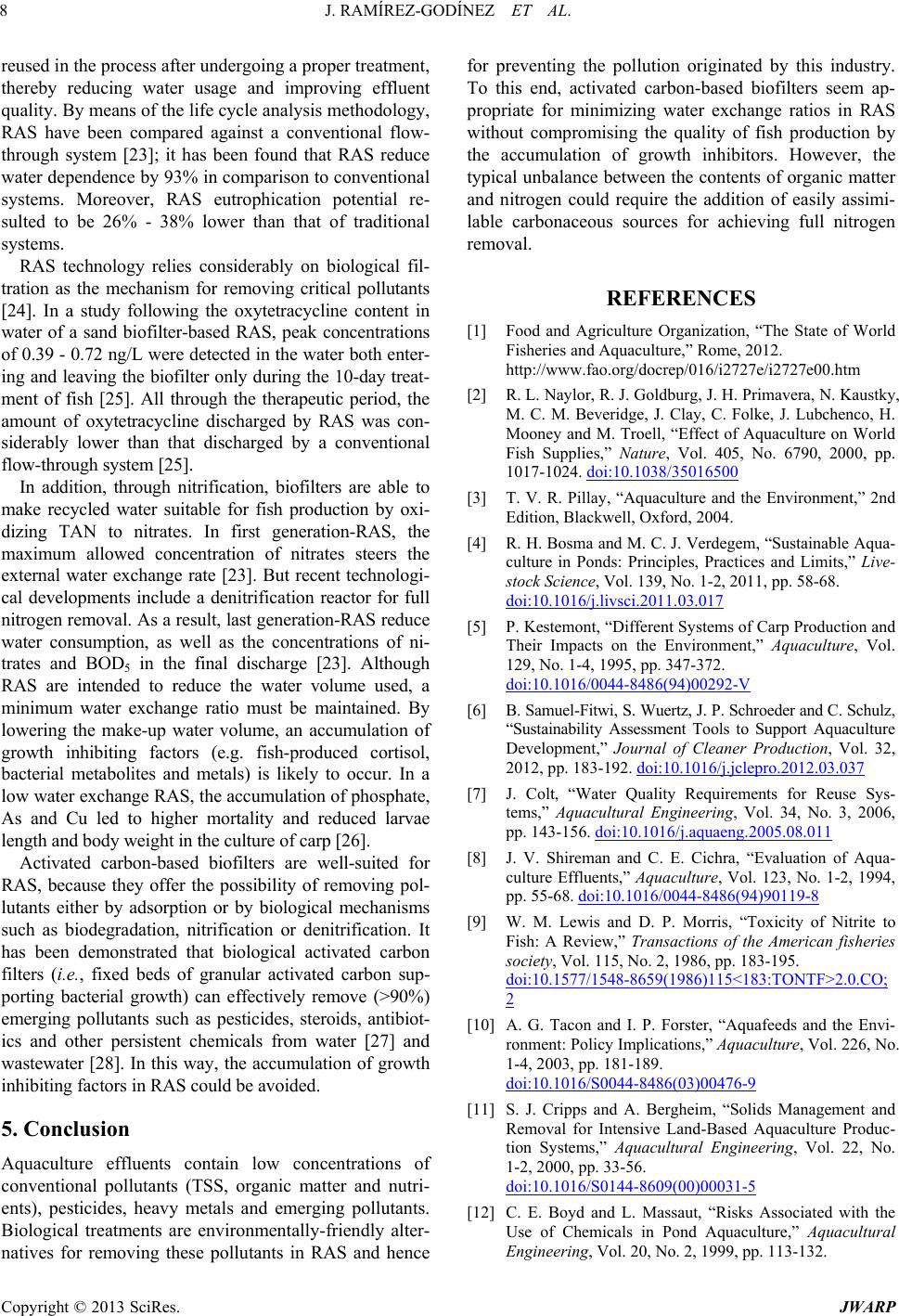 J. RAMÍREZ-GODÍNEZ ET AL. 8 reused in the process after undergoing a proper treatment, thereby reducing water usage and improving effluent quality. By means of the life cycle analysis methodology, RAS have been compared against a conventional flow- through system [23]; it has been found that RAS reduce water dependence by 93% in comparison to conventional systems. Moreover, RAS eutrophication potential re- sulted to be 26% - 38% lower than that of traditional systems. RAS technology relies considerably on biological fil- tration as the mechanism for removing critical pollutants [24]. In a study following the oxytetracycline content in water of a sand biofilter-based RAS, peak concentrations of 0.39 - 0.72 ng/L were detected in the water both enter- ing and leaving the biofilter only during the 10-day treat- ment of fish [25]. All through the therapeutic period, the amount of oxytetracycline discharged by RAS was con- siderably lower than that discharged by a conventional flow-through system [25]. In addition, through nitrification, biofilters are able to make recycled water suitable for fish production by oxi- dizing TAN to nitrates. In first generation-RAS, the maximum allowed concentration of nitrates steers the external water exchange rate [23]. But recent technologi- cal developments include a denitrification reactor for full nitrogen removal. As a result, last generation-RAS reduce water consumption, as well as the concentrations of ni- trates and BOD5 in the final discharge [23]. Although RAS are intended to reduce the water volume used, a minimum water exchange ratio must be maintained. By lowering the make-up water volume, an accumulation of growth inhibiting factors (e.g. fish-produced cortisol, bacterial metabolites and metals) is likely to occur. In a low water exchange RAS, the accumulation of phosphate, As and Cu led to higher mortality and reduced larvae length and body weight in the culture of carp [26]. Activated carbon-based biofilters are well-suited for RAS, because they offer the possibility of removing pol- lutants either by adsorption or by biological mechanisms such as biodegradation, nitrification or denitrification. It has been demonstrated that biological activated carbon filters (i.e., fixed beds of granular activated carbon sup- porting bacterial growth) can effectively remove (>90%) emerging pollutants such as pesticides, steroids, antibiot- ics and other persistent chemicals from water [27] and wastewater [28]. In this way, the accumulation of growth inhibiting factors in RAS could be avoided. 5. Conclusion Aquaculture effluents contain low concentrations of conventional pollutants (TSS, organic matter and nutri- ents), pesticides, heavy metals and emerging pollutants. Biological treatments are environmentally-friendly alter- natives for removing these pollutants in RAS and hence for preventing the pollution originated by this industry. To this end, activated carbon-based biofilters seem ap- propriate for minimizing water exchange ratios in RAS without compromising the quality of fish production by the accumulation of growth inhibitors. However, the typical unbalance between the contents of organic matter and nitrogen could require the addition of easily assimi- lable carbonaceous sources for achieving full nitrogen removal. REFERENCES [1] Food and Agriculture Organization, “The State of World Fisheries and Aquaculture,” Rome, 2012. http://www.fao.org/docrep/016/i2727e/i2727e00.htm [2] R. L. Naylor, R. J. Goldburg, J. H. Primavera, N. Kaustky, M. C. M. Beveridge, J. Clay, C. Folke, J. Lubchenco, H. Mooney and M. Troell, “Effect of Aquaculture on World Fish Supplies,” Nature, Vol. 405, No. 6790, 2000, pp. 1017-1024. doi:10.1038/35016500 [3] T. V. R. Pillay, “Aquaculture and the Environment,” 2nd Edition, Blackwell, Oxford, 2004. [4] R. H. Bosma and M. C. J. Verdegem, “Sustainable Aqua- culture in Ponds: Principles, Practices and Limits,” Live- stock Science, Vol. 139, No. 1-2, 2011, pp. 58-68. doi:10.1016/j.livsci.2011.03.017 [5] P. Kestemont, “Different Systems of Carp Production and Their Impacts on the Environment,” Aquaculture, Vol. 129, No. 1-4, 1995, pp. 347-372. doi:10.1016/0044-8486(94)00292-V [6] B. Samuel-Fitwi, S. Wuertz, J. P. Schroeder and C. Schulz, “Sustainability Assessment Tools to Support Aquaculture Development,” Journal of Cleaner Production, Vol. 32, 2012, pp. 183-192. doi:10.1016/j.jclepro.2012.03.037 [7] J. Colt, “Water Quality Requirements for Reuse Sys- tems,” Aquacultural Engineering, Vol. 34, No. 3, 2006, pp. 143-156. doi:10.1016/j.aquaeng.2005.08.011 [8] J. V. Shireman and C. E. Cichra, “Evaluation of Aqua- culture Effluents,” Aquaculture, Vol. 123, No. 1-2, 1994, pp. 55-68. doi:10.1016/0044-8486(94)90119-8 [9] W. M. Lewis and D. P. Morris, “Toxicity of Nitrite to Fish: A Review,” Transactions of the American fisheries society, Vol. 115, No. 2, 1986, pp. 183-195. doi:10.1577/1548-8659(1986)115<183:TONTF>2.0.CO; 2 [10] A. G. Tacon and I. P. Forster, “Aquafeeds and the Envi- ronment: Policy Implications,” Aquaculture, Vol. 226, No. 1-4, 2003, pp. 181-189. doi:10.1016/S0044-8486(03)00476-9 [11] S. J. Cripps and A. Bergheim, “Solids Management and Removal for Intensive Land-Based Aquaculture Produc- tion Systems,” Aquacultural Engineering, Vol. 22, No. 1-2, 2000, pp. 33-56. doi:10.1016/S0144-8609(00)00031-5 [12] C. E. Boyd and L. Massaut, “Risks Associated with the Use of Chemicals in Pond Aquaculture,” Aquacultural Engineering, Vol. 20, No. 2, 1999, pp. 113-132. Copyright © 2013 SciRes. JWARP 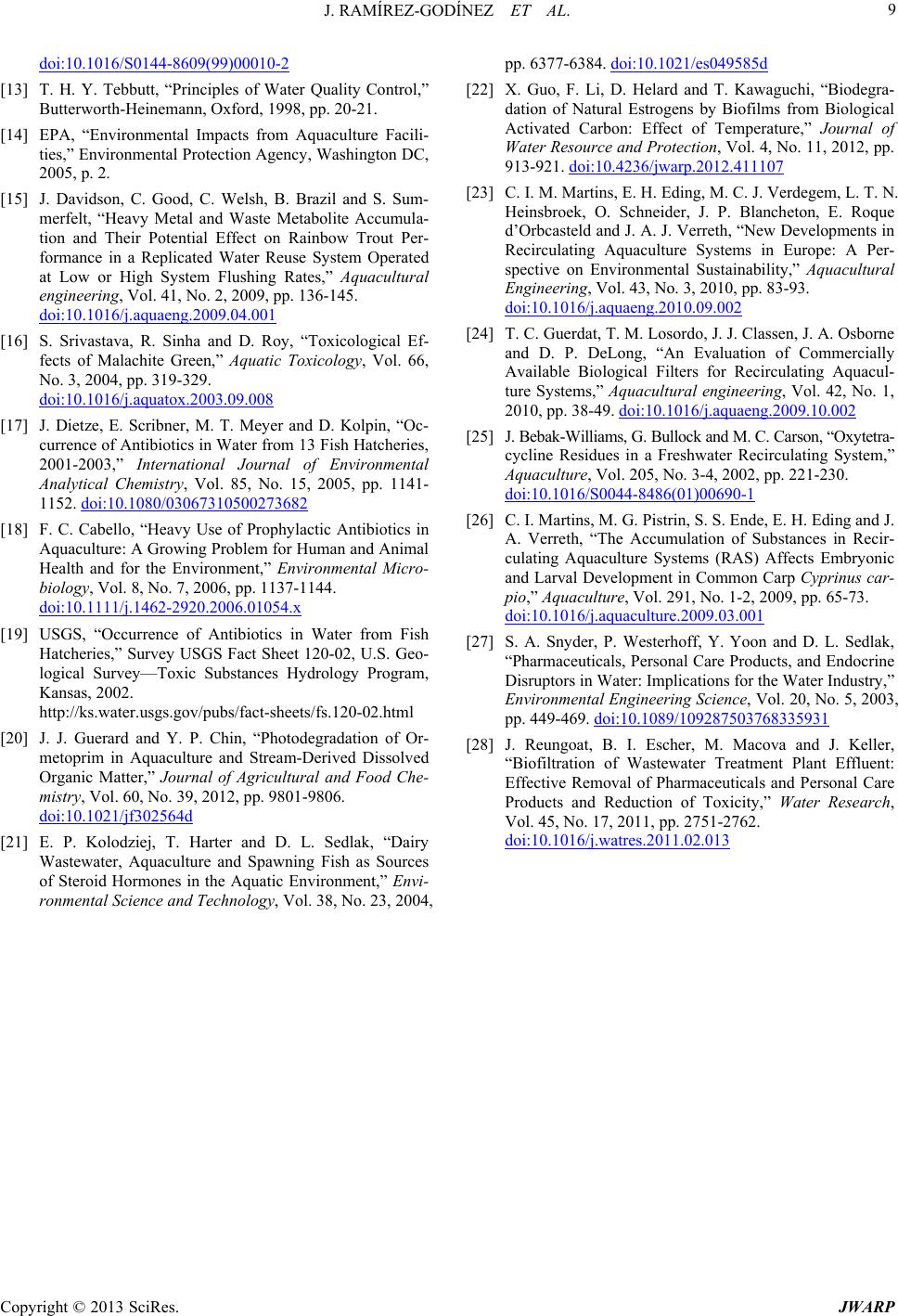 J. RAMÍREZ-GODÍNEZ ET AL. Copyright © 2013 SciRes. JWARP 9 doi:10.1016/S0144-8609(99)00010-2 [13] T. H. Y. Tebbutt, “Principles of Water Quality Control,” Butterworth-Heinemann, Oxford, 1998, pp. 20-21. [14] EPA, “Environmental Impacts from Aquaculture Facili- ties,” Environmental Protection Agency, Washington DC, 2005, p. 2. [15] J. Davidson, C. Good, C. Welsh, B. Brazil and S. Sum- merfelt, “Heavy Metal and Waste Metabolite Accumula- tion and Their Potential Effect on Rainbow Trout Per- formance in a Replicated Water Reuse System Operated at Low or High System Flushing Rates,” Aquacultural engineering, Vol. 41, No. 2, 2009, pp. 136-145. doi:10.1016/j.aquaeng.2009.04.001 [16] S. Srivastava, R. Sinha and D. Roy, “Toxicological Ef- fects of Malachite Green,” Aquatic Toxicology, Vol. 66, No. 3, 2004, pp. 319-329. doi:10.1016/j.aquatox.2003.09.008 [17] J. Dietze, E. Scribner, M. T. Meyer and D. Kolpin, “Oc- currence of Antibiotics in Water from 13 Fish Hatcheries, 2001-2003,” International Journal of Environmental Analytical Chemistry, Vol. 85, No. 15, 2005, pp. 1141- 1152. doi:10.1080/03067310500273682 [18] F. C. Cabello, “Heavy Use of Prophylactic Antibiotics in Aquaculture: A Growing Problem for Human and Animal Health and for the Environment,” Environmental Micro- biology, Vol. 8, No. 7, 2006, pp. 1137-1144. doi:10.1111/j.1462-2920.2006.01054.x [19] USGS, “Occurrence of Antibiotics in Water from Fish Hatcheries,” Survey USGS Fact Sheet 120-02, U.S. Geo- logical Survey—Toxic Substances Hydrology Program, Kansas, 2002. http://ks.water.usgs.gov/pubs/fact-sheets/fs.120-02.html [20] J. J. Guerard and Y. P. Chin, “Photodegradation of Or- metoprim in Aquaculture and Stream-Derived Dissolved Organic Matter,” Journal of Agricultural and Food Che- mistry, Vol. 60, No. 39, 2012, pp. 9801-9806. doi:10.1021/jf302564d [21] E. P. Kolodziej, T. Harter and D. L. Sedlak, “Dairy Wastewater, Aquaculture and Spawning Fish as Sources of Steroid Hormones in the Aquatic Environment,” Envi- ronmental Science and Technology, Vol. 38, No. 23, 2004, pp. 6377-6384. doi:10.1021/es049585d [22] X. Guo, F. Li, D. Helard and T. Kawaguchi, “Biodegra- dation of Natural Estrogens by Biofilms from Biological Activated Carbon: Effect of Temperature,” Journal of Water Resource and Protection, Vol. 4, No. 11, 2012, pp. 913-921. doi:10.4236/jwarp.2012.411107 [23] C. I. M. Martins, E. H. Eding, M. C. J. Verdegem, L. T. N. Heinsbroek, O. Schneider, J. P. Blancheton, E. Roque d’Orbcasteld and J. A. J. Verreth, “New Developments in Recirculating Aquaculture Systems in Europe: A Per- spective on Environmental Sustainability,” Aquacultural Engineering, Vol. 43, No. 3, 2010, pp. 83-93. doi:10.1016/j.aquaeng.2010.09.002 [24] T. C. Guerdat, T. M. Losordo, J. J. Classen, J. A. Osborne and D. P. DeLong, “An Evaluation of Commercially Available Biological Filters for Recirculating Aquacul- ture Systems,” Aquacultural engineering, Vol. 42, No. 1, 2010, pp. 38-49. doi:10.1016/j.aquaeng.2009.10.002 [25] J. Bebak-Williams, G. Bullock and M. C. Carson, “Oxytetra- cycline Residues in a Freshwater Recirculating System,” Aquaculture, Vol. 205, No. 3-4, 2002, pp. 221-230. doi:10.1016/S0044-8486(01)00690-1 [26] C. I. Martins, M. G. Pistrin, S. S. Ende, E. H. Eding and J. A. Verreth, “The Accumulation of Substances in Recir- culating Aquaculture Systems (RAS) Affects Embryonic and Larval Development in Common Carp Cyprinus car- pio,” Aquaculture, Vol. 291, No. 1-2, 2009, pp. 65-73. doi:10.1016/j.aquaculture.2009.03.001 [27] S. A. Snyder, P. Westerhoff, Y. Yoon and D. L. Sedlak, “Pharmaceuticals, Personal Care Products, and Endocrine Disruptors in Water: Implications for the Water Industry,” Environmental Engineering Science, Vol. 20, No. 5, 2003, pp. 449-469. doi:10.1089/109287503768335931 [28] J. Reungoat, B. I. Escher, M. Macova and J. Keller, “Biofiltration of Wastewater Treatment Plant Effluent: Effective Removal of Pharmaceuticals and Personal Care Products and Reduction of Toxicity,” Water Research, Vol. 45, No. 17, 2011, pp. 2751-2762. doi:10.1016/j.watres.2011.02.013
|